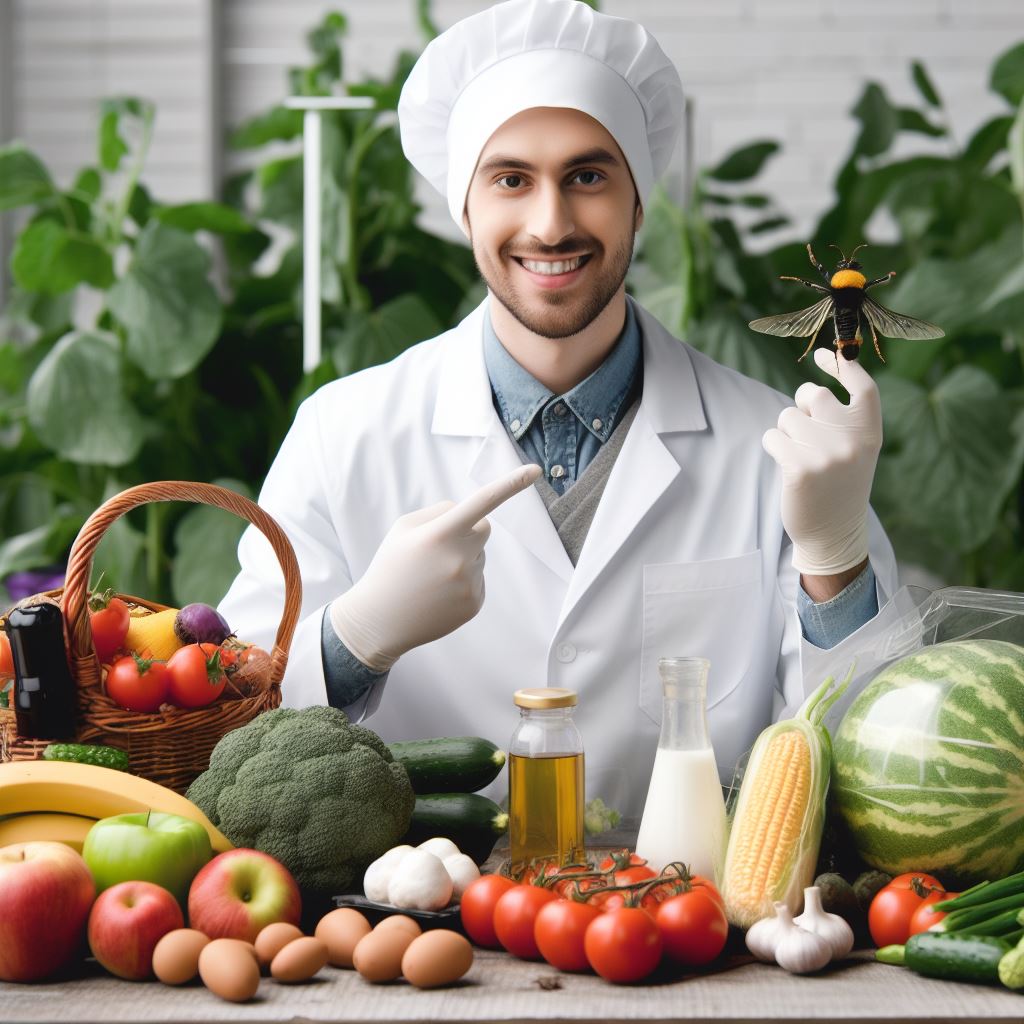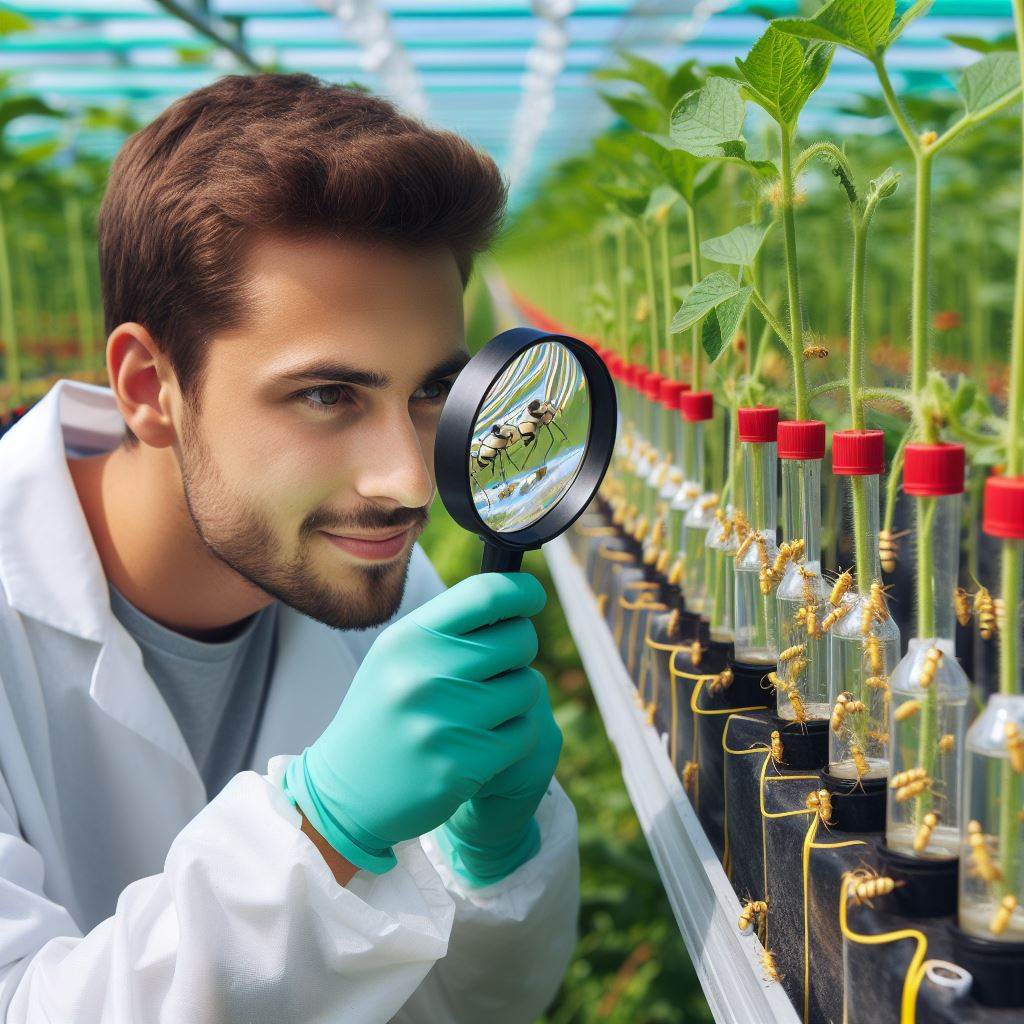Introduction
IPM, which stands for Integrated Pest Management, is a method that combines different techniques to control pests.
Reducing pesticide use and increasing yields in farming are crucial for sustainable and efficient agricultural practices.
In the face of escalating concerns about the environmental impact of traditional farming practices, Integrated Pest Management (IPM) emerges as a beacon of sustainable agriculture.
Beyond merely reducing pesticide usage, IPM embodies a holistic ethos that harmonizes with nature.
It encourages the deployment of beneficial insects, employs crop rotation strategies, and leverages advanced technologies to monitor and manage pest populations judiciously.
This nuanced approach not only safeguards the delicate ecological balance but also holds the promise of elevating agricultural productivity.
By mitigating the risks associated with chemical-intensive methods, IPM fosters resilient crops and healthier ecosystems.
Farmers, researchers, and environmentalists alike are increasingly recognizing the manifold benefits of this integrative methodology, not merely as a response to the adverse effects of pesticides but as a proactive measure towards sustainable and profitable agriculture.
As we embark on this exploration of IPM, we will unravel the intricacies of its methodologies, delve into its success stories, and ponder the challenges it faces.
Join us in this journey to understand how IPM stands at the forefront of a new era in farming—one that prioritizes both the bountiful yields demanded by a growing population and the preservation of the delicate tapestry of our environment.
What is IPM?
Definition and explanation of IPM principles
In agricultural practices, Integrated Pest Management (IPM) refers to an ecological approach that focuses on reducing the use of pesticides and maximizing crop yields.
Components of IPM
IPM is based on the following principles:
- Identification: To effectively manage pests, it is crucial to accurately identify the target organisms and understand their life cycles and behavior.
- Monitoring: Regular monitoring of pest populations helps determine the severity of infestation and helps inform the appropriate course of action.
- Prevention: IPM emphasizes the use of preventive measures to minimize pest problems. This includes maintaining healthy soil, using disease-resistant crop varieties, and implementing good agricultural practices.
- Control: When pest populations exceed the economic threshold, measures are taken to control their numbers. IPM utilizes a combination of cultural, biological, and chemical control methods.
Benefits of adopting IPM practices
By adopting IPM practices, farmers and growers can benefit in several ways:
- Reduced pesticide use: IPM aims to minimize pesticide applications, thereby mitigating the risks associated with chemical exposure for humans, wildlife, and the environment.
- Cost savings: By relying less on pesticides, farmers can reduce input costs while still effectively managing pests.
- Enhanced yield: IPM strategies focus on optimizing crop production by targeting pests at the right time, ensuring minimal yield losses.
- Preservation of beneficial organisms: IPM considers the importance of beneficial organisms, such as pollinators and natural enemies of pests, thereby maintaining ecological balance.
- Reduced pesticide resistance: The diverse approaches used in IPM help prevent pests from developing resistance to specific pesticides, ensuring their long-term effectiveness.
- Improved food safety: IPM practices reduce pesticide residues in food, making it safer for consumers and reducing potential health risks.
- Sustainable agriculture: By promoting environmentally friendly practices, IPM contributes to the overall sustainability of agricultural systems.
In short, Integrated Pest Management (IPM) is an effective and sustainable approach to pest control.
By employing the principles of identification, monitoring, prevention, and control, farmers can reduce reliance on pesticides while maximizing crop yields.
Transform Your Agribusiness
Unlock your farm's potential with expert advice tailored to your needs. Get actionable steps that drive real results.
Get StartedThe adoption of IPM practices offers numerous benefits, including reduced pesticide use, cost savings, enhanced yields, preservation of beneficial organisms, decreased pesticide resistance, improved food safety, and promotion of sustainable agriculture.
Implementing IPM strategies is a win-win situation for both farmers and the environment.
Read: Chemical-Free IPM: Pros and Cons
Reducing Pesticides through IPM
Importance of minimizing pesticide usage
Reducing the use of pesticides is crucial for environmental sustainability and human health.
Pesticides can contaminate soil, water, and food, posing risks to ecosystems and human populations.
Minimizing pesticide usage helps safeguard biodiversity by protecting beneficial organisms and pollinators.
By reducing pesticides, we can promote the development of resistant pest populations, requiring higher doses in the future.
Use of biological controls in IPM (beneficial insects, parasites, predators)
Biological controls, such as beneficial insects, parasites, and predators, are valuable components of IPM.
Beneficial insects, like ladybugs and lacewings, feed on pests, reducing the need for chemical interventions.
Parasites and predators, such as nematodes and birds, can effectively control pest populations without pesticides.
These biological controls target pests specifically and are environmentally friendly solutions.
Crop rotation and diversification as a strategy to control pests without heavy reliance on pesticides
Crop rotation and diversification are effective strategies within IPM to control pests without excessive pesticide usage.
Changing crop varieties and rotating crops disrupts pest life cycles, reducing pest populations and damage.
Planting diverse crops creates a less favorable environment for pests, decreasing the need for chemical interventions.
Transform Your Agribusiness Online Presence
Stand out with compelling content tailored to engage your audience and drive results. From blog posts to social media, we’ll create what your business needs to grow.
Get StartedThis approach also enhances soil health, improves nutrient availability, and increases overall crop productivity.
Utilizing physical barriers, traps, and cultural practices to prevent pest infestations
In IPM, physical barriers such as nets, fences, and screens can prevent insects and larger pests from damaging crops.
Traps, such as pheromone traps, attract pests and help in monitoring and controlling their populations.
Cultural practices like pruning, sanitation, and proper irrigation can reduce pest infestations and limit their damage.
These non-chemical methods provide effective alternatives to pesticide usage.
Integrating modern technologies like precision farming and smart sensors for better pest management
Modern technologies like precision farming and smart sensors offer advanced tools for pest management within IPM.
Precision farming uses data and GPS technology to apply pesticides only where and when necessary, minimizing overall usage.
Smart sensors detect pest populations early, allowing for targeted interventions and reducing the need for broad-scale spraying.
By utilizing these technologies, farmers can optimize pest control while minimizing environmental impacts.
In fact, reducing pesticide usage through IPM is of great importance for sustainable agriculture.
By incorporating biological controls, crop rotation, physical barriers, and modern technologies, we can achieve better pest management.
This approach not only reduces the harmful impacts of pesticides but also enhances overall crop yields and environmental health.
Read: Cultural Practices in IPM for Soil Health
Boosting Yields with IP
Boosting crop yields is a primary goal for farmers worldwide.
Unlock Farming Insights for Growth
Make smarter farming decisions with detailed reports on market trends, weather patterns, and soil health tailored to your farm's success. Boost productivity with actionable data.
Get ReportThrough Integrated Pest Management (IPM), farmers can not only reduce pesticide usage but also enhance their yield outcomes by adopting various sustainable practices.
Let’s explore some key ways in which IPM can significantly boost yields:
Increased Crop Health and Resilience through Reduced Pest Pressure
IPM focuses on preventive measures and biological controls to manage pests effectively.
By identifying and monitoring pest populations, farmers can implement targeted interventions.
This approach reduces pest pressure, minimizing crop damage and promoting healthier plants.
As a result, crops are more resilient and less susceptible to yield-reducing factors, leading to increased overall yields.
Enhanced Soil Fertility and Nutrient Management Techniques in IPM
IPM practices prioritize soil health as a crucial element in maximizing crop performance.
By incorporating organic fertilizers, cover crops, and crop rotation, farmers can enrich soil fertility.
This enrichment improves nutrient availability for plants, enhancing their growth, development, and yield potential.
Additionally, healthy soils support beneficial microbial activity, further benefiting crop productivity.
Optimizing Water Usage and Irrigation Practices for Better Yield Outcomes
Water scarcity is a significant challenge for agriculture. IPM encourages farmers to adopt efficient irrigation systems and water management techniques, such as drip irrigation and moisture sensors.
With better water conservation practices, farmers can minimize water wastage and ensure optimal water supply to crops.
Proper irrigation contributes to improved plant growth, leading to enhanced yields.
Improved Crop Quality due to Reduced Pesticide Residues
Traditional pesticide-dependent farming often leads to the presence of harmful residues on crops, posing health risks and reducing market value.
IPM reduces reliance on pesticides by integrating multiple pest control methods.
As a result, crops have lower pesticide residues, making them safer for consumption and improving their market appeal.
This increased quality offers farmers better opportunities for profitability.
Case Studies and Success Stories of Farmers who Experienced Yield Improvements with IPM
Various success stories and case studies from farmers around the world provide real-life evidence of IPM’s effectiveness in increasing yields.
For example, a farmer in Africa implemented IPM techniques and experienced a 30% increase in crop yields, enabling financial stability for their family.
Such success stories inspire other farmers to adopt IPM, promoting sustainable agriculture with improved yield outcomes.
IPM offers a holistic approach to crop production, emphasizing long-term sustainability and economic viability.
By prioritizing crop health, soil fertility, water management, and reducing pesticide residues, farmers can significantly boost their yields.
Adopting IPM practices not only benefits individual farmers but also contributes to a more sustainable and resilient agricultural system.
The combination of these strategies ensures optimal outcomes for both the environment and the farmers’ livelihoods.
Read: Tech Advances in IPM for Sustainability

Overcoming Challenges in Implementing IPM
Familiarizing farmers with IPM principles and techniques
One of the main challenges in implementing IPM is ensuring that farmers are familiar with its principles and techniques.
This can be addressed by providing comprehensive training programs and workshops that focus on IPM.
These programs should cover topics such as identifying pests, monitoring pest populations, and implementing appropriate control methods.
By equipping farmers with the necessary knowledge, they can effectively apply IPM strategies on their farms.
Proactive education and training programs for farmers on IPM adoption
Education and training play a crucial role in promoting the adoption of IPM among farmers.
Proactive programs that provide ongoing support and guidance can greatly enhance the implementation of IPM.
These programs should include practical demonstrations, field visits, and access to expert advice.
Through continuous learning, farmers can develop the skills and confidence necessary to successfully implement IPM practices.
Collaborative efforts between farmers, government agencies, and research institutions to promote IP
Implementing IPM requires collaboration between various stakeholders, including farmers, government agencies, and research institutions.
By establishing partnerships, knowledge sharing and resource allocation can be optimized.
Government agencies can provide funding and policy support, while research institutions can contribute valuable insights into IPM strategies.
This collaborative approach ensures that all parties are working together towards a common goal of reducing pesticides and increasing yields.
Economic Considerations and cost-effective Practices in IPM Adoption
One key challenge in adopting IPM is the potential cost associated with implementing new practices and technologies.
Addressing economic considerations is crucial in encouraging farmers to transition to IPM.
Farmers need access to affordable and effective IPM tools and methods that can be easily integrated into their existing farming systems.
Creating financial incentives and providing financial support for IPM adoption can help overcome this challenge.
Addressing farmer concerns and misconceptions about IPM
Some farmers may have concerns or misconceptions about implementing IPM on their farms.
These concerns may stem from a lack of understanding or fear of potential risks.
Addressing these concerns through clear communication and providing evidence-based information is crucial.
Engaging with farmers and addressing their questions can help dispel myths and promote confidence in IPM adoption.
In essence, the successful implementation of IPM requires overcoming various challenges through education, collaboration, and addressing economic considerations.
Familiarizing farmers with IPM principles, providing proactive education and training programs, and encouraging collaboration between stakeholders are key strategies.
Furthermore, considering economic factors and addressing farmer concerns and misconceptions are also essential in promoting IPM adoption.
By addressing these challenges head-on, IPM can become a widely adopted and effective approach in reducing pesticides and boosting yields for sustainable agriculture.
Read: Natural Predators: Allies in IPM
Conclusion
It is crucial to recognize the significance of reducing pesticides and improving yields in modern farming.
The negative impacts of excessive pesticide use on the environment and human health cannot be ignored.
By implementing IPM practices, farmers can achieve a harmonious balance between pest control and crop productivity.
Integrated Pest Management offers a promising solution for farmers, providing them with a holistic approach that minimizes pesticide usage while increasing yields.
By using a combination of cultural, mechanical, biological, and chemical controls, farmers can effectively manage pests without relying solely on harmful chemicals.
It is essential to encourage farmers to embrace IPM practices, as this will not only lead to healthier crops but also protect the environment and biodiversity.
By adopting IPM, farmers can reduce their ecological footprint and contribute to the overall sustainability of the agricultural sector.
The future of sustainable farming lies in the widespread adoption of IPM.
Through continuous research and technological advancements, farmers can enhance their understanding of pest behavior and develop innovative IPM strategies.
This will enable them to combat pests effectively while ensuring the long-term viability of their farms.
Overall, by reducing pesticide use and boosting yields through IPM, farmers can achieve a more sustainable and environmentally friendly approach to farming.
By embracing this change, they not only benefit their own farms but also contribute to preserving the planet for future generations.




